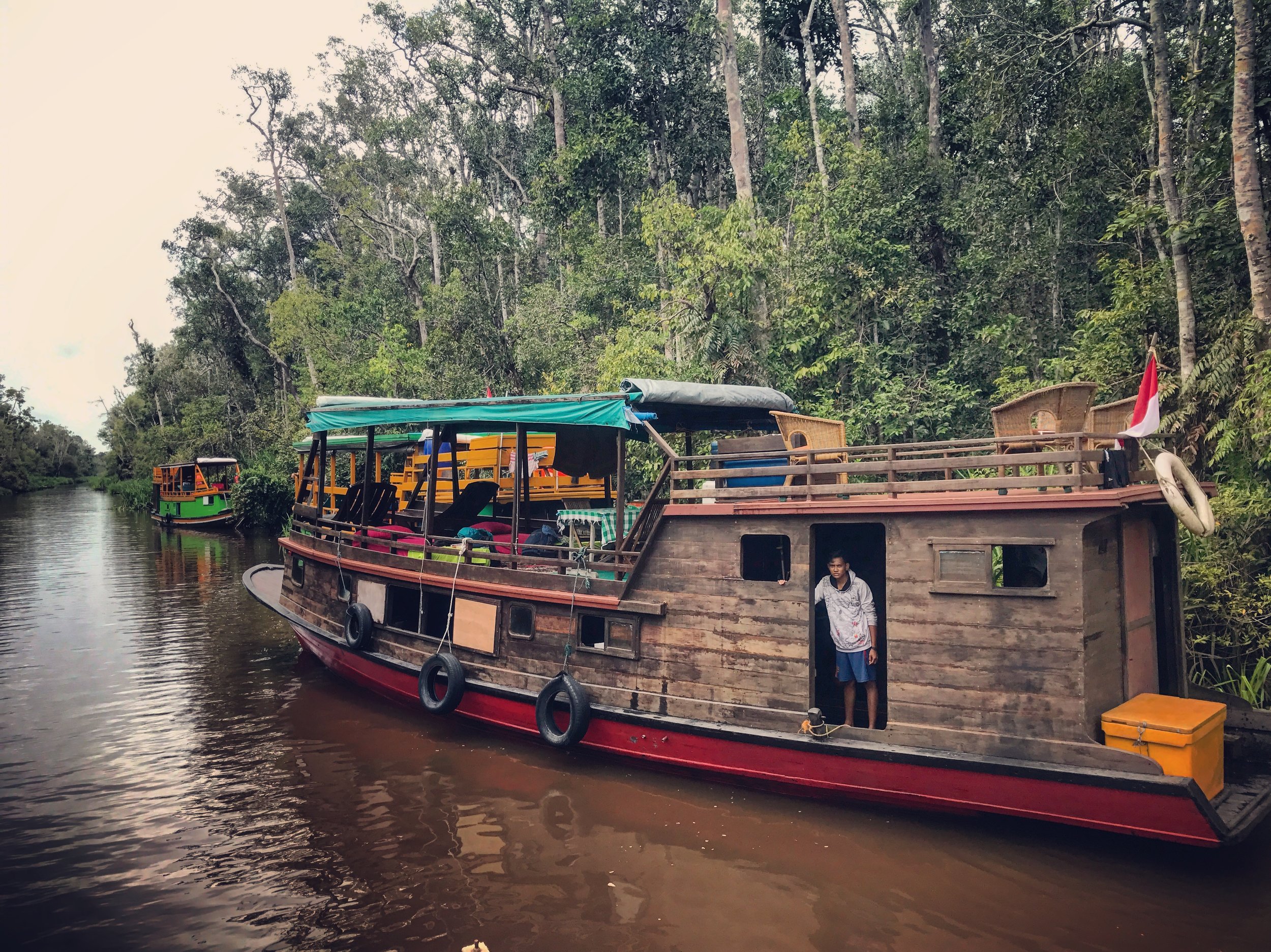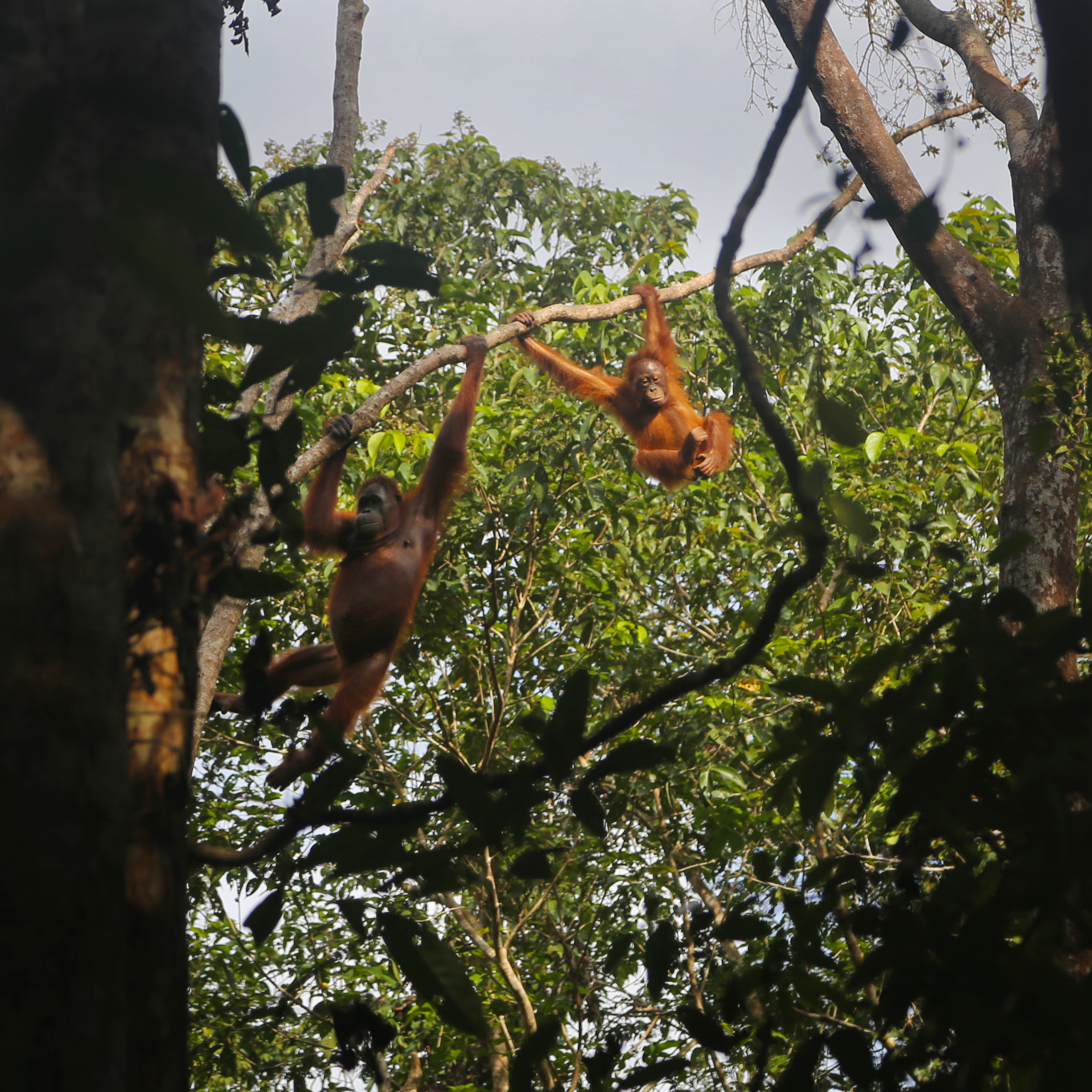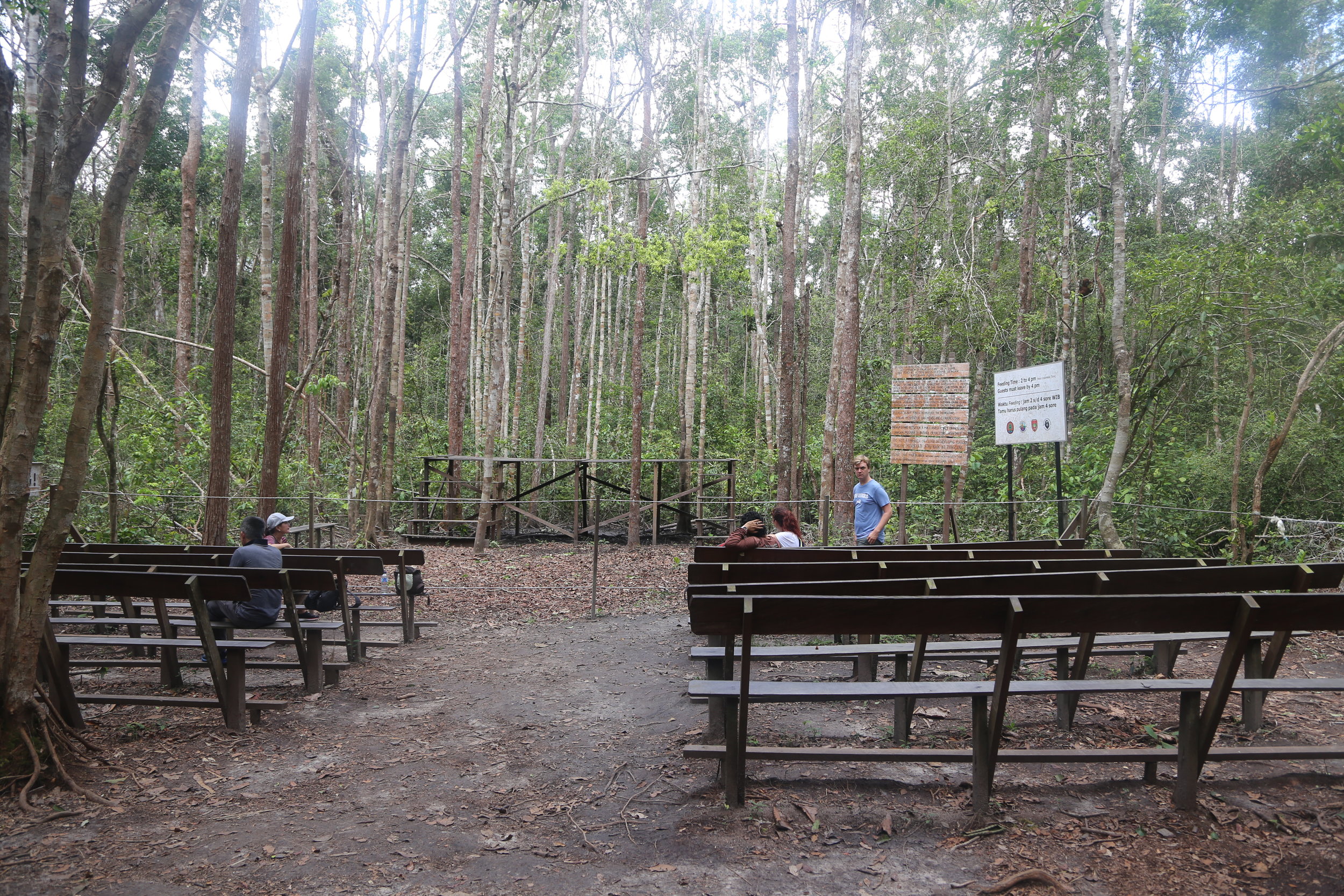An orangutan in Tanjung Puting National Park.
After a seemingly endless journey at times (Flights: NYC > Tokyo > Jakarta > Pangkalan Bun = about 22 hours in flight, plus additional time spent at the airports) we finally arrived in Kumai, Kalimantan to begin our journey upriver to view orangutans in the forests of Borneo.
As we approached Kumai we began to see many multi-story, grey, windowless buildings towering over the smaller village homes and shops. Our guide informed us that the buildings were owned by Chinese entrepreneurs and were essentially swallow nest farms. The nests, produced from the saliva of the birds, is a Chinese delicacy and the farms have taken over the town - much to the dismay of many locals. The birds are loud, the poop profuse, and the buildings unsightly (some were painted with fake windows in an failed attempt to blend into the surroundings).
Kumai from the water, swallow nest buildings towering over the smaller local homes and businesses.
We booked our tour through Orangutan Days. They were incredibly accommodating and understanding when we made a mistake with our booking. They were quick to respond and offered a perfect solution. Our guide, Iim, grew up in the area, was passionate about orangutans, and had worked at Camp Leakey for many years. He spoke often and longingly about a desire to return to work there once his children are older.
A Klotok
We spent two days and nights aboard a Klotok, a traditional two-story, wooden boat. The lower level included the crew quarters, the kitchen, and a small rustic bathroom with a western style toilet and a simple shower utilizing water from a barrel on the deck above. The second level was our main ‘living’ space, with a covered roof but otherwise open to the elements and allowing for a great view and comfortable breeze. We had wooden lounge chairs on the bow, rattan chairs on a third-level seating area at the stern and in the middle was a dinning table and two beds. Onboard with us we had our guide, two boatmen, and a female cook who made excellent vegan food for us throughout the trip. Klotok’s move at a leisurely pace, making the cruise portion of the tour an excellent way to get into vacation mode and it was trip highlight for us overall.
It was a fun experience from the start, the port was small and many boats were docked to together so we had to climb through three or four other boats before arriving at ours. All of the boats were artful and slightly different from one another. We began our journey up the Kumai River with the Tanjung Puting National Park on our right. The landscape slowly changed from mangroves and leafy palms to tall trees. Once among the tall trees it wasn’t long before we spotted large families of proboscis monkeys in the trees. They live in families of 30 or 40 and are only native to Borneo. Proboscis monkeys are medium sized, with light reddish brown fur and really large funny noses. It was really cool to watch them move and jump through the trees, there were quite a few babies as well. We saw them frequently throughout our journey especially in the mornings and evenings.
After lazily boating for a few hours we arrived at our first stop, the research center of Tanjung Harapan. We popped into their tiny museum (which could use a serious update) to learn about the work they do and then hung out for a bit watching the locals sort through a boat load of bananas and sugarcane for the orangutans.
From there we headed into the forest for the 3pm feeding. After a short walk we suddenly heard a loud crashing ahead that sounded like trees falling down. Looking up we saw some tree tops swaying wildly, a large male orangutan was on his way to the feeding area. Orangutans are the largest tree-dwelling animals on earth - so you hear them when they are coming! All of us tourists were quietly gathering on benches about 20 yards away from the feeding platform, pointing and whispering and snapping our cameras. Once the food arrived we saw about three or four additional female orangutans come and go, each with a baby or young child in tow. It was fascinating to watch them appear distantly in the tree tops. They’d slowly sway their way over to the platform, climb down, grab as many bananas as then could and then usually climb back up to dine. The babies and children almost always clinging to their moms. Their movements so human and alien all at the same time.
Unlike other primates, orangutans are largely solitary. However, they have a very intense relationship between mother and child. The mom will carry her child with her for the first five or six years of their life, and she is their constant companion for another couple of years before they start to explore the world on their own. Because of this the birth rates are low - about once every eight to ten years.
That evening we went on a short night walk through the forest, spotting large scary looking tarantulas, poisonous snakes, glowing mushrooms, and other frightening creatures before running (just kidding) back to the boat for dinner. When we arrived back at the boat we found that the crew had arranged our sleeping area with fresh sheets and a large mosquito net. We fell asleep listening to the wild sounds of the forest - quite a chorus!
We got an early start the next day, stopping briefly at the tiny Sekonyer village across the river. It seemed like an interesting place, I wish I had a bit more time to explore it. Then we were on our way boating further upriver to Pondok Tanggui for their 9am feeding. Despite the rain, we still got to see a few orangutans have their daily fruit snack. Lots of other tourists were also in attendance, even more than the day before - everyone jostling for a photo and dodging rain drops.
After that we were back on the boat for a few more hours, up to the Sekonyer River with it’s black water, eventually arriving at Camp Leakey. We stopped by their museum/info center, which felt nearly as out dated as the one at Tanjung Harapan. It was really lacking information on what the camp is currently doing and most importantly how visitors can help orangutans. It seemed like a failed opportunity to raise awareness (and collect donations) on important issues threatening orangutans today - like palm oil farming.
From there we followed our guide deeper into the woods towards the feeding area. On the way there we spotted a gibbon swinging and gliding his way to the platform as well. It was so cool to watch, like something out of a cartoon fairytale. I found his movements mesmerizing. I could have easily spent the better part of a day following him around.
Again, no male orangutans came to this one, but a few ladies with their babies and one with an older child who was starting to venture further and further away from mom - much to her seeming frustration at times. One mom came in from behind us with her baby clinging to her side. With a lack of crowd control, she soon found herself nearly surrounded by thoughtless people welding their iPhones and gro-pros desperate for photos of her. Eventually, with what looked like real reluctance, she had to come down and walk on the benches in the viewing area in order to reach the feeding platform. She seemed a bit stressed - or maybe I am just projecting my own emotions onto her - but eventually she and her little one made it safely and began to munch on bananas. Meanwhile a large wild pig roamed around under the platform and trees, waiting for dropped banana peels to rain down.
On our way back to the boat we came upon an elderly orangutan that our guide recognized as Ahmed. Iim explained that Ahmed has cataracts and can't see very well. He’s also an ex-captive orangutan and though he can roam anywhere he wants in the forest, he’s comfortable around people and seemed content to sit trailside. We gave him a good couple yards of space, but sat with him for a moment before another group caught up to us. It felt special to be so close, I wish we could have sat with him a little longer.
Joel and I with Ahmed.
Back on the boat we had another long ride back down river. We spent the time relaxing, reading our books and monkey spotting. We also saw a horn billed bird and very large bats. The sun began to set and it was a very magical magic hour, puttering along on our artful wooden boat, waving at monkeys as the sky turned pink and gold.
The sunsetting on our last night on the river.





























